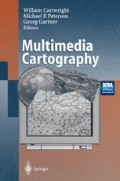Abstract
The most vital issues in multimedia cartography are not technical issues. Cartographic multimedia has great potential for human geographers and social scientists engaged in attempts to understand and represent complex human and social environments through space and over time. This potential can be realised if we, as cartographers, approach cartographic multimedia as a substantive method, with a conceptual and theoretical foundation, rather than as a technology in search of applications. In this chapter I suggest that the idea of praxis — an explicitly theorised practice — should underpin our approach to and understanding of multimedia cartography.
Access this chapter
Tax calculation will be finalised at checkout
Purchases are for personal use only
Preview
Unable to display preview. Download preview PDF.
References
Blades M, Spencer C (1986) The Implications of Psychological Theory and Methodology for Cognitive Cartography. Cartographica 23: 1–13
Board C (1967) Maps as Models. In: Chorley R and Haggett P (eds) Models in Geography. Methuen, London, pp 671–725
Bolter J (1991) Writing Space. Lawrence Erlbaum, Hillsdale NJ
Chang K (1997) The Design of a Web-based Geographic Information System for Community Participation. Master’s Project, State University of New York at Buffalo, Department of Geography. (copy available at http://www.geog.buffalo.edu/—jkrygier/)
Cosgrove D (1984) Social Formation and Symbolic Landscape. Barnes and Noble, Totawa NJ Dervin B (1998)
Chaos, Order, and Sense-Making: A Proposed Theory for Information Design. Unpaginated. (copy available at http://edfu.lis.uiuc.edu/allerton/95/s5/dervin.draft.html)
DiBiase D, MacEachren A, Krygier J, Reeves C (1992) Animation and the Role of Map Design in Scientific Visualization. Cartography and Geographic Information Systems 19: 201–214
Dorling D, Fairbairn D (1997) Mapping: Ways of Representing the Word. Longman, Essex.
Ebel R (1982) The Future of Educational Research. Educational Researcher 11: 18–19
Giddens A (1984) The Constitution of Society. Polity Press, Cambridge
Hagerstrand T (1982) Diorama, Path, and Project. Tijdschrift voor Economische en Sociale Geografie 73: 323–356
Keates J (1964) Cartographic Communication. In: Abstracts of Papers, the 20th International Geographical Congress, London
Kolacny A (1969) Cartographic Information — A Fundamental Term in Modern Cartography. Cartographic Journal 6: 47–49
Krygier J (1994) Sound and Cartographic Visualization. In: Taylor D and MacEachren A (eds) Visualization in Modern Cartography. Pergamon Press, Oxford
Krygier J (1996) Geography and Cartographic Design. In: Wood C and Keller C. Cartographic Design: Theoretical and Practical Perspectives. Wiley, Chichester, pp 19–34
Krygier J, Reeves C, DiBiase D, and Cupp J (1997a) Design, Implementation and Evaluation of Multimedia Resources for Geography and Earth Science Education. Journal of Geography in Higher Education 21: 17–39
Krygier J (1997b) Envisioning the American West: Maps, The Representational Barrage of 19th Century Expedition Reports, and the Production of Scientific Knowledge. Cartography and Geographical Information Systems 24, pp 27–50
Krygier J (1998) Public Participation Visualization. Paper presented at the 1998 Association of American Geographers Meeting, Boston MA. (copy available at http://www.geog.buffalo.eduL-jkrygier).
Landow G (1992) Hypertext: The Convergence of Contemporary Critical Theory and Technology. Johns Hopkins University Press, Baltimore
MacEachren A (1994) Visualization in Modern Cartography: Setting the.Agenda. In: MacEachren A, Taylor DRF (ed) Visualization in Modern Cartography. Pergamon, Oxford, pp 1–12
MacEachren A (1995) How Maps Work. Guilford Press, New York.
Reeves T (1992) Evaluating Schools Infused with Technology. Education and Urban Society 24: 519–534.
Robinson A. (1952) The Look of Maps. University of Wisconsin Press, Madison WI.
Robinson A (1979) Geography and Cartography Then and Now. Annals of the Association of American Geographers 69: 97–102.
Sayer A (1992) Method in Social Science: A Realist Approach. Routledge, London
Wood D (1987) Pleasure in the Idea: The Atlas as Narrative Form. Cartographica 24: 24–46
Author information
Authors and Affiliations
Editor information
Editors and Affiliations
Rights and permissions
Copyright information
© 1999 Springer-Verlag Berlin Heidelberg
About this chapter
Cite this chapter
Krygier, J.B. (1999). Cartographic Multimedia and Praxis in Human Geography and the Social Sciences. In: Cartwright, W., Peterson, M.P., Gartner, G. (eds) Multimedia Cartography. Springer, Berlin, Heidelberg. https://doi.org/10.1007/978-3-662-03784-3_23
Download citation
DOI: https://doi.org/10.1007/978-3-662-03784-3_23
Publisher Name: Springer, Berlin, Heidelberg
Print ISBN: 978-3-662-03786-7
Online ISBN: 978-3-662-03784-3
eBook Packages: Springer Book Archive

